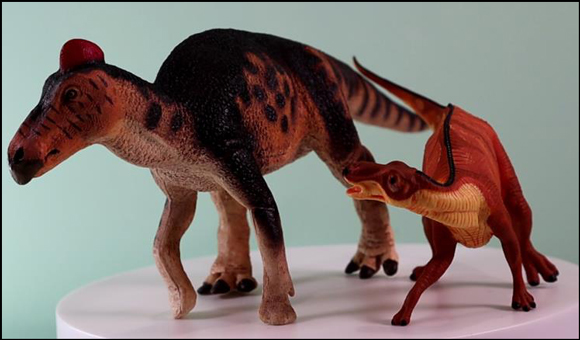Digging Out “Dakota” – One Grain of Rock at a Time
Update on the Late Cretaceous Edmontosaurus Mummy
A team of dedicated researchers are carefully removing the sandstone from around the mummified remains of an Edmontosaurus dinosaur, so far the researchers estimate that they have removed about 600 kilogrammes of rock, each grain delicately chipped away from the exquisitely preserved fossil.
The fossil, a duck-billed dinosaur from the very end of the Cretaceous (Maastrichtian faunal stage), estimated to be around 66 million years old is being prepared for display in a room below North Dakota’s state museum (Bismarck, North Dakota). When completed this part of the fossil will join the arm which is already on display alongside other prehistoric animal attractions such as mosasaurs and the skull of a Triceratops.
Uncovering this dinosaur, nicknamed “Dakota” by the research team, has taken more than two years so far, but according to state palaeontologist John Hoganson, of the North Dakota Geological Survey, work is now about three-quarters complete.
State geologist Ed Murphy commented on the amount of rock material removed from around the fossil:
“One thousand pounds, one gramme at a time. It’s mind-numbing and hand-numbing work.”
However, this particular Edmontosaurus should be free from the rest of its sandstone tomb and join the rest of the exhibit on display at the North Dakota state museum early next year.
Two Models of an Edmontosaurus

Two Safari Ltd Edmontosaurus models. Both these Edmontosaurus figures come from the Safari Ltd range.
Picture credit: Everything Dinosaur
The picture shows two Edmontosaurus dinosaur models, both produced by Safari Ltd.
To read more about the discovery of this remarkable mummified dinosaur: Mummified Dinosaur Begins to Reveal its Secrets.
Edmontosaurus
Four preparators have spend upwards of 3,800 hours slowly chipping away at the matrix of rock that surrounds the mummified dinosaur. Experts believe the specimen may have preserved tendons, ligaments and possibly some internal organs, making “Dakota” one of the most complete and best preserved specimens in existence. Not too bad when you consider the fossil also contains the remains of a crocodilian that got trapped as it fed on the dinosaur carcase.
Such is the exquisite preservation that this particular dinosaur fossil has been the subject of intensive research and has been featured in a National Geographic documentary. The specimen was discovered by PhD palaeontology student Tyler Lyson in 1999, but excavation work on the fossil did not start until 2004. The fossil was eventually removed from the dig site in two huge sandstone blocks, several tonnes in weight and slowly but surely the scientists have been able to extract the fossil from its rock matrix.
During the preparation scientific work has continued and Everything Dinosaur team members published information on some remarkable work carried out by Manchester University researchers who had been able to identify the preserved remains of organic molecules from the skin of this remarkable specimen.
To read more about the research work on “Dakota”: Amazing Dinosaur Mummy Yields More Secrets
Work on one section of the huge fossil, the rock containing the tail and an arm was completed earlier. These are on display at the Bismarck based museum.
Daily progress unearthing the plant-eating beast is nearly imperceptible to most people. It takes much skill to remove rock without damaging the skin of the dinosaur, Hoganson remarked.
He went onto add:
“It takes so long to do very little.”
This is a sentiment we can echo, as team members at Everything Dinosaur work on a number of fossils found in the United Kingdom. Even a small ammonite can take a while to prepare, patience is certainly a virtue amongst palaeontologists.
Amy Sakariassen, working part-time on the fossil stated that removing a coin-sized area a few millimetres thick is a good day at work.
She stated:
“Your mind can’t wander, you have to pay attention.”
Researchers use air brades and air scribes that act like miniature chisels, they remove the rock surrounding the delicate fossil grain by grain. It is important that the researchers have their wits about them as the hardened tips of these tools can blast away the fossil just as easily as the matrix.
Researching “Dakota”
One fact the research team are fairly confident about is that despite being over 8 metres long and perhaps weighing as much as 4 tonnes, “Dakota” was not fully grown when it died.
“Dakota’s” remains were fossilised in a crumpled heap, with the beast effectively bent in half. Sediment from a river channel somehow covered the creature quickly, which allowed its skin and other elements of the dinosaur to be preserved in superb detail.
The scientists are confident that this amazing dinosaur fossil will yield more secrets before the work is completed and “Dakota” can take its place as the star attraction at the North Dakota state museum.
To view the Safari Ltd range of dinosaur models including Edmontosaurus (whilst stocks last): Wild Safari Prehistoric World Figures.

